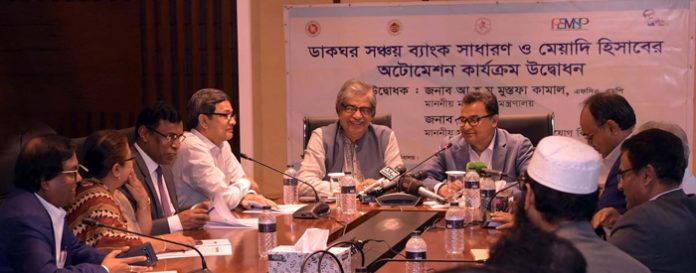DHAKA, March 11, 2020 (BSS) – After the national savings schemes, the post
office saving schemes have also come under automation in a bid to bring much
more transparency and discipline into the operation of these savings tools.
Finance Minister AHM Mustafa Kamal and Post and Telecommunication Division
Minister Mustafa Jabbar formally inaugurated a web-based database system
today for conducting the automation operation of the post office savings bank
general and term accounts schemes under the Postal Department at the Finance
Division Conference Room at Bangladesh Secretariat here today.
NBR Chairman and IRD Senior Secretary Abu Hena Md Rahmatul Muneem and
Finance Division Secretary Abdur Rouf Talukder spoke on the occasion while
Director General of National Savings Shamsunnahar Begum, Director General of
Postal Directorate Sudhangshu Shekhar Bhadra and Finance Division Additional
Secretary M Habibur Rahman were present, among others, on the occasion.
Two separate accounts of two youths were also opened during that time
under this automation system.
Speaking on the occasion as the chief guest, the Finance Minister said the
wide-scale operations of this automation system as well as the previous
interest rates of the post office savings tools would become effective from
March 17 this year marking the birth centenary of Father of the Nation
Bangabandhu Sheikh Mujibur Rahman.
He said from that day the interest rates of the general scheme under post
office would return to its previous 7.50 percent while that of the three-year
term scheme at 11.28 percent.
“We want to restore discipline in these schemes (post office) as well as
to stop misuse of those. We’ll also ensure the use of TIN numbers and
national IDs so that the operations of these tools come into a disciplined
way,” he said.
Kamal said from today there would remain no doubt and confusion over the
operations of these tools adding, “There were some distortions when the
system was manual. But, now those won’t exist anymore as we hope to deliver
these products in a transparent way.”
He said the government wants to see that the different saving schemes
remain in operation for the concerned groups of people who really deserve
those. “We don’t want to interfere with the interest of people rather we want
to make those more perfect through giving necessary logistical support.”
He also said the government does not want that the big businessmen come to
take benefits from the post office savings tools.
Asked whether there is any risk for spreading COVID-19 through the bank
notes, Kamal said the Bangladesh Bank usually deals with the bank notes.
“There is no such fear (of spreading Novel corona virus through notes). The
transactions will continue. But, time is coming up for us to go into cashless
transactions,”
Post and Telecommunication Division Minister Mustafa Jabbar said due to
the farsighted steps from the present government, the traditional countrywide
post offices have now turned into digital post offices.
Mentioning that no other department of the government has such strong
network at the grassroots level except the postal department, Jabbar said
they are trying to use this network as a strong one for digital commerce.
He also hoped that the automation activities of these post office savings
tools would benefit further the lower and middle income class people.
NBR Chairman Abu Hena Md Rahmatul Muneem said since there will be a ceiling
of maximum investment under the post office saving schemes, no one would be
able to invest going beyond the limit for which the interest of the small
savers would be protected.
Finance Division Secretary Abdur Rouf Talukder informed that some 200
postal department officials received training under this automation system
and 4,000 more officials would undergo training to spread the operations of
this system up to upazlia levels.
Earlier on July 1, 2019, the transactions of four well-circulated savings
schemes like five-year term Bangladesh savings certificates, three-month
profit bearing savings certificates, family savings certificates and
pensioner savings certificates came under automation.
Currently some 1,659 branches of banks, post offices and savings bureau
are conducting transactions through using this web-based system.



